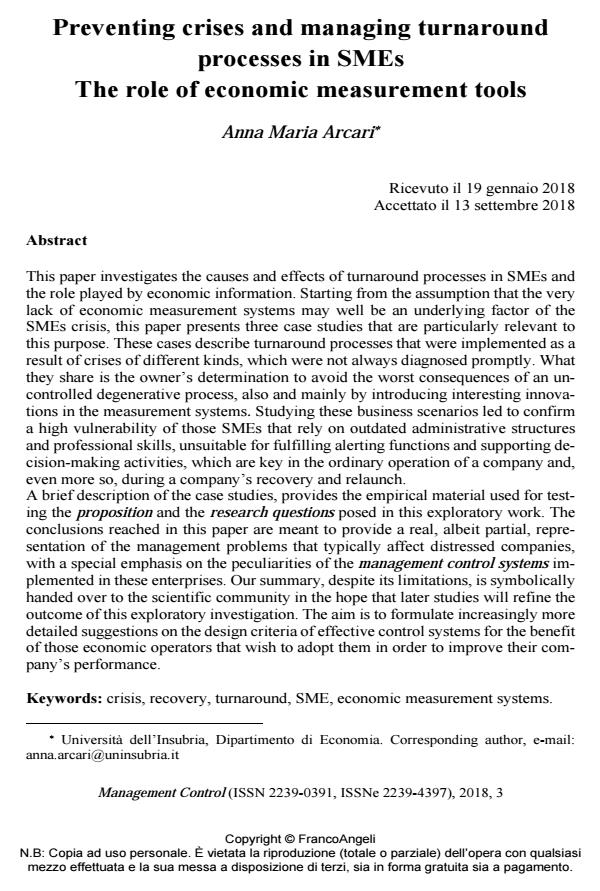Preventing crises and managing turnaround processes in SMEs The role of economic measurement tools
Titolo Rivista MANAGEMENT CONTROL
Autori/Curatori Anna Maria Arcari
Anno di pubblicazione 2018 Fascicolo 2018/3
Lingua Inglese Numero pagine 25 P. 131-155 Dimensione file 336 KB
DOI 10.3280/MACO2018-003007
Il DOI è il codice a barre della proprietà intellettuale: per saperne di più
clicca qui
Qui sotto puoi vedere in anteprima la prima pagina di questo articolo.
Se questo articolo ti interessa, lo puoi acquistare (e scaricare in formato pdf) seguendo le facili indicazioni per acquistare il download credit. Acquista Download Credits per scaricare questo Articolo in formato PDF

FrancoAngeli è membro della Publishers International Linking Association, Inc (PILA)associazione indipendente e non profit per facilitare (attraverso i servizi tecnologici implementati da CrossRef.org) l’accesso degli studiosi ai contenuti digitali nelle pubblicazioni professionali e scientifiche
This paper investigates the causes and effects of turnaround processes in SMEs and the role played by economic information. Starting from the assumption that the very lack of economic measurement systems may well be an underlying factor of the SMEs crisis, this paper presents three case studies that are particularly relevant to this purpose. These cases describe turnaround processes that were implemented as a result of crises of different kinds, which were not always diagnosed promptly. What they share is the owner’s determination to avoid the worst consequences of an uncontrolled degenerative process, also and mainly by introducing interesting innovations in the measurement systems. Studying these business scenarios led to confirm a high vulnerability of those SMEs that rely on outdated administrative structures and professional skills, unsuitable for fulfilling alerting functions and supporting decision-making activities, which are key in the ordinary operation of a company and, even more so, during a company’s recovery and relaunch. A brief description of the case studies, provides the empirical material used for testing the proposition and the research questions posed in this exploratory work. The conclusions reached in this paper are meant to provide a real, albeit partial, representation of the management problems that typically affect distressed companies, with a special emphasis on the peculiarities of the management control systems implemented in these enterprises. Our summary, despite its limitations, is symbolically handed over to the scientific community in the hope that later studies will refine the outcome of this exploratory investigation. The aim is to formulate increasingly more detailed suggestions on the design criteria of effective control systems for the benefit of those economic operators that wish to adopt them in order to improve their company’s performance.
Parole chiave:Crisis, recovery, turnaround, SME, economic measurement systems.
- Sustainable Governance Andrea Cardoni, Evgeniia Kiseleva, pp.145 (ISBN:978-3-031-37491-3)
- Sustainable Governance Andrea Cardoni, Evgeniia Kiseleva, pp.67 (ISBN:978-3-031-37491-3)
- Management control systems package e turnaround: un caso aziendale Cristiana Cattaneo, Sara Sonzogni, in MANAGEMENT CONTROL 1/2021 pp.151
DOI: 10.3280/MACO2021-001008 - 2021 IEEE International Conference on Systems, Man, and Cybernetics (SMC) Daniel Husson, Alexander Holland, Madjid Fathi, Rocio Arteaga Sanchez, pp.3303 (DOI:10.1109/SMC52423.2021.9659298)
- The relevance of cash flow information in predicting corporate bankruptcy in Italian private companies Simone Poli, Marco Gatti, in MANAGEMENT CONTROL 1/2024 pp.179
DOI: 10.3280/MACO2024-001009 - Pressione competitiva e previsione dell'insolvenza Velia Gabriella Cenciarelli, Marco Maria Mattei, Giulio Greco, in MANAGEMENT CONTROL 3/2020 pp.35
DOI: 10.3280/MACO2020-003003 - I modelli predittivi della crisi e dell'insolvenza aziendale. Una systematic review Luca Ianni, Gianluca Marullo, Stefania Migliori, Francesco De Luca, in MANAGEMENT CONTROL 2/2021 pp.127
DOI: 10.3280/MACO2021-002007
Anna Maria Arcari, Preventing crises and managing turnaround processes in SMEs The role of economic measurement tools in "MANAGEMENT CONTROL" 3/2018, pp 131-155, DOI: 10.3280/MACO2018-003007